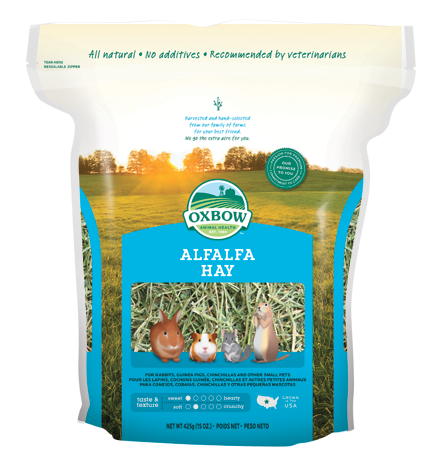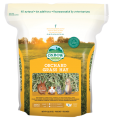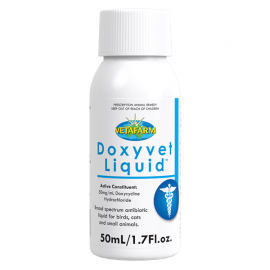Oxbow Alfalfa Hay
Oxbow Alfalfa Hay is a high-fiber legume hay with the same long-strand fiber found in grass hays, but with more protein, energy and calcium. This hay is perfect for young or lactating animals that need concentrated nutrition. The succulent taste stimulates the appetite of ill or post-surgical animals. Once an animal reaches adulthood or completes recovery, this nutritious forage should be replaced with a grass hay. Alfalfa Hay, mixed with any other Oxbow grass hay, creates a rich, flavorful and nutritious treat.
Oxbow Alfalfa Hay is a high-fiber legume hay with the same long-strand fiber found in grass hays, but with more protein, energy and calcium. This hay is perfect for young or lactating animals that need concentrated nutrition. The succulent taste stimulates the appetite of ill or post-surgical animals. Once an animal reaches adulthood or completes recovery, this nutritious forage should be replaced with a grass hay. Alfalfa Hay, mixed with any other Oxbow grass hay, creates a rich, flavorful and nutritious treat.
Alfalfa Hay is a high-fiber legume forage hay that is sometimes called the "Queen of Forages". It differs from grass hays such as timothy, orchard grass and brome in the leaf, stem, and root structure. Alfalfa Hay is legume hay and the protein, calcium and energy content are higher than in grass hay. Because we take special care and bale at night, you will find that Oxbow's Alfalfa Hay have a soft stem with the leaves attached.
Oxbow's Alfalfa Hay is an outstanding feed for young animals. It contains more crude protein, digestible energy, and calcium levels than any other forage. In addition, it has the fiber content needed for normal digestive functioning. Alfalfa provides the essential calcium necessary for growing bones. Alfalfa is also a source of important minerals, including phosphorus, potassium, magnesium, sulfur, iron, zinc and selenium.
Oxbow's Alfalfa Hay should not be fed to all animals. But if used carefully, in certain situations, it can be a valuable tool in nutritional management.
Due to it's succulent taste, Oxbow's Alfalfa Hay can be used as an appetite stimulant when an animal is ill or for post surgical patients. Because it is high in fiber, a small pinch can be given as a treat.
-
TypeHay
-
Package Size15 Oz.
-
BrandOxbow
-
UPC744845402154
- Guaranteed Analysis
-
Protein (% min)16.0
-
Fat (% min)1.5
-
Fiber (% max)32.0
-
Moisture (% max)15.0
-
Feeding Directions
Growing Animals (under 6 months): Unlimited amounts, plus free choice grass hay.
Mature Animals: Occasional small amounts.
Nursing Females: Unlimited amounts in addition to free choice grass hay.
Alfalfa Hay should only be offered carefully to mature rabbits, guinea pigs,chinchillas, and prairie dogs due to the higher protein and calcium content.
Many vets believe that animals prone to kidney stones, bladder stones or calcium crystals in their urine should always avoid alfalfa.
- Alfalfa Hay can be used to help animals gain weight and will give a nice shine to their fur.
- Elderly animals should be fed foods they enjoy, such as alfalfa, when considering quality of life.
- Alfalfa Hay can be used in small amounts as an appetite stimulant for thin or convalescing animals.
- Rabbits, guinea pigs and chinchillas under six months of age can be given Alfalfa Hay daily.
- After six months of age an animal should begin a gradual transition to 100% grass hay such as Oat Hay, Western Timothy, Orchard Grass or Bunny Brome.
How much do I feed daily?
Alfalfa Hay can be fed daily to growing animals as 25% of their total dietary intake. Adult animals should be limited to a SMALL pinch as a treat.









